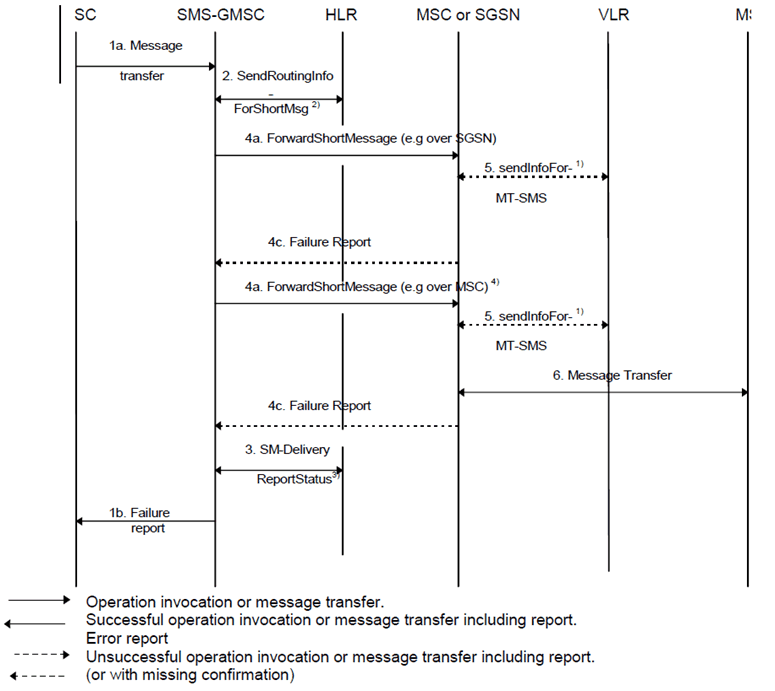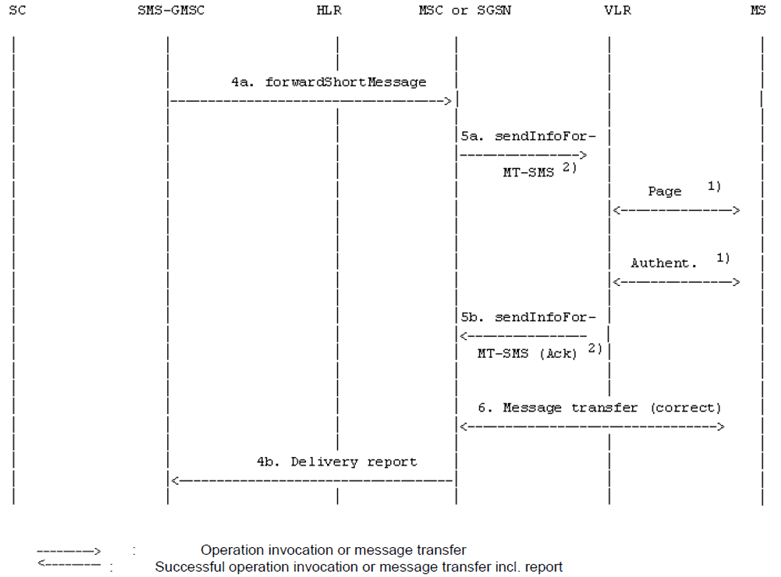Content for TS 23.040 Word version: 18.0.0
0…
3…
3.3…
4…
8…
9…
9.2…
9.2.2.2…
9.2.2.3…
9.2.3…
9.2.3.12…
9.2.3.24
9.2.3.24.1…
9.2.3.24.10…
9.2.3.24.10.1.12…
9.2.3.24.10.2…
9.2.3.24.11…
9.2.3.25…
9.3…
10…
10.1.1…
10.1.3…
10.1.5…
10.1.7…
10.1.9…
10.1.11…
10.1.13…
10.1.15…
10.1.17…
10.2
10.2.1…
10.2.3…
10.2.5…
10.2.7…
10.3
11…
A…
C
C.1…
C.3…
C.5…
C.7…
C.9…
C.11…
C.13…
C.15…
D…
E…
F…
G…
G.2…
G.6
G.7
H…
I…
J…
K…
10.1.11 — fig. 15h p. 122

Figure 15h: Short message transfer attempt failing over the first path (e.g. SGSN) and over the second path (e.g. MSC)
(⇒ copy of original 3GPP image)
(⇒ copy of original 3GPP image)
Operation 1:
Message transfer SC → SMS-GMSC.
This operation is used to transfer a short message from an SC to an SMS-GMSC.
The operation consists of:
Operation 2:
- the transfer of a message containing the TPDU from the SC to the SMS-GMSC (see "1a. Message transfer" in Figure 15); and
- the return of either a "Failure report" (see 1c. in Figure 15) or a "Delivery report" (see 1b. in Figure 15).
sendRoutingInfoForShortMsg.
The operation is an interrogation of the HLR by the SMS-GMSC or the SMS Router to retrieve information necessary to deliver the short message.
The result may contain the MSC, SGSN, both MSC and SGSN addresses, or the address of the SMS Router. It shall also indicate which address belongs to the MSC and the SGSN, however, it shall not indicate if the address belongs to an SMS Router (as the SMS Router poses as either an MSC or an SGSN or both to the SMS-GMSC).
Operation 3:
SM-DeliveryReportStatus.
The operation provides a means for the SMS-GMSC to request the HLR to add an SC address to the MWD, and is activated when the SMS-GMSC receives an absent subscriber indication from the MSC, SGSN or both, and/or when the SMS-GMSC receives a failure report for a short message transfer with cause MS Memory Capacity Exceeded via the MSC or SGSN. The Return Result optionally contains the MSIsdn-Alert or IMSI-Alert.
This operation is also activated at successful delivery short message when the MNRF, MNRG or both are set in HLR.
The operation consists of:
Operation 4:
- the transfer of a message, containing the MSISDN or IMSI of the MS to which the short message was addressed, the SC-address, the successful outcome and/or the causes (Absent Subscriber, MS memory capacity exceeded or both) for updating the MWD, from the SMS-GMSC to the HLR (see 3. in Figure 15).
forwardShortMessage.
The operation provides a means for the SMS-GMSC to transfer a short message to the MSC or to the SGSN at which the MS is currently located, via an SMS Router if deployed by the HPLMN of the receiving MS.
The operation works in tandem with the forwarding of the short message from the MSC or from the SGSN to the MS. Thus, the outcome of the operation comprises either success, i.e. that the message has been delivered to the MS; or a failure that may be caused by several reasons, e.g. failure in the transfer SMS-GMSC → MSC or SMS-GMSC → SGSN, MS being detached, MS being temporarily unreachable (e.g. due to eDRX), or no paging response.
It should be noted that the MNRG setting is implicitly carried out in the SGSN when the message transfer is denied due to GPRS DETACH.
Operation 5:
sendInfoForMT-SMS.
The operation provides a means for the MSC to retrieve subscriber information from VLR for mobile terminated short message transfer. The operation may be associated with an authentication procedure, as shown in Figure 16. Unsuccessful retrieval (e.g. absent subscriber) is indicated by a cause indication to the SMS-GMSC.
An overall depiction of how operation 5 interacts with signalling on the radio path is given in Figure 16.
It should be noted that the MNRF setting is implicitly carried out when the message transfer is denied due to IMSI DETACH.
Operation 6:
Message transfer MSC → MS.
The operation is used to transfer a short message from the MSC to the MS.
If the transfer is not successful, e.g. due to the MS losing radio coverage after having successfully authenticated, a failure report (RP-ERROR) is returned to the SMS-GMSC. In this case, MWD and MCEF in the HLR shall be updated only for the case where the transfer fails with cause MS Memory Capacity Exceeded.
If the MS notifies the network that the MS has been unable to accept a short message because its memory capacity has been exceeded, then the ME shall set the memory capacity Exceeded Notification flag if present.
Operation 7:
InformSC.
The operation is used to transfer the MSIsdn-Alert or IMSI-Alert from the HLR to the SMS-GMSC if the error Absent Subscriber or a positive result is given as an answer to the operation SendRoutingInfoForSM.
10.1.12 — fig. 16a p. 124

Figure 16a: "Send information for MT SMS" procedure; error free case
(⇒ copy of original 3GPP image)
(⇒ copy of original 3GPP image)